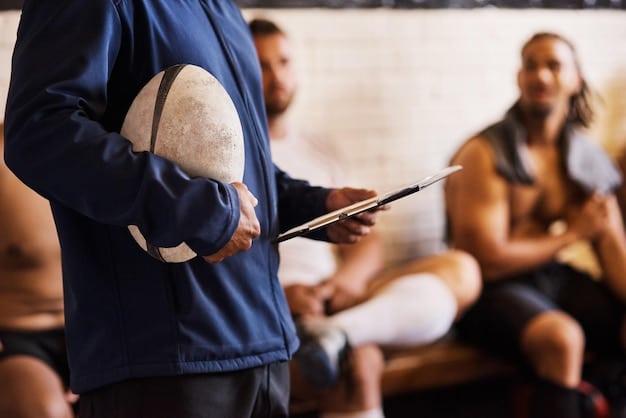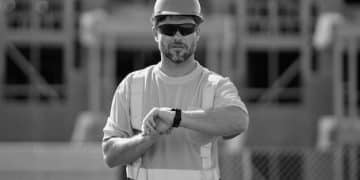Latest Advances in NFL Sports Injury Prevention Tech

The latest advancements in sports injury prevention technology for NFL teams include wearable sensors, advanced data analytics, personalized training programs, and innovative field designs aimed at reducing the risk and severity of injuries.
The relentless pace and physical demands of the National Football League (NFL) place athletes at constant risk of injury, making injury prevention a top priority. What Are the Latest Advancements in Sports Injury Prevention Technology for NFL Teams? The answer lies in a blend of wearable tech, data analytics, and innovative training methods.
Wearable Sensor Technology: A New Era of Athlete Monitoring
Wearable sensor technology has revolutionized how NFL teams monitor their athletes’ physical condition and risk of injury. These devices provide real-time data on various metrics, offering unprecedented insights into player health.
Tracking Player Biometrics
Wearable sensors track a plethora of biometrics, including heart rate, acceleration, and the force of impacts. This data helps teams understand the physiological stress each player endures during practices and games.
Real-Time Data Analysis
The data collected from wearable sensors is analyzed in real-time, providing immediate feedback to trainers and coaches. This allows for timely interventions to prevent potential injuries.

Here are key benefits of using wearable sensors:
- Provide personalized insights into each player’s physical condition.
- Enable early detection of fatigue and potential overtraining.
- Help optimize training programs to reduce injury risk.
Wearable sensor technology marks a significant leap forward in sports medicine, providing NFL teams with invaluable tools to safeguard their athletes’ health and prolong their careers. It’s a proactive approach to injury prevention that’s transforming the league.
Data Analytics: Predicting and Preventing Injuries
Data analytics has become an essential component of sports injury prevention. By analyzing vast datasets, NFL teams can identify patterns and risk factors associated with injuries, leading to more effective prevention strategies.
Identifying Risk Factors
Data analytics involves scrutinizing various factors such as player history, injury records, and performance metrics. By doing so, teams can pinpoint athletes who are at a higher risk of specific injuries.
Predictive Modeling
Predictive modeling uses algorithms to forecast the likelihood of injuries based on historical and real-time data. This allows teams to take proactive measures to mitigate those risks.
Key applications of data analytics in injury prevention include:
- Customizing training regimens based on individual risk profiles.
- Implementing targeted interventions for at-risk players.
- Optimizing player workload during practices and games.
Data analytics empowers NFL teams to make data-driven decisions that prioritize player safety, transforming reactive treatment approaches into proactive prevention plans. The integration of data analytics is reshaping how teams approach player health.
Personalized Training Programs: Tailoring Workloads
Personalized training programs represent a significant advancement in injury prevention. These programs are designed to meet the unique needs and risk profiles of individual athletes, optimizing their performance while minimizing injury risks.
Individualized Workloads
Personalized training tailors the intensity and duration of workouts to each player’s specific needs. This approach ensures that players are challenged appropriately without being pushed beyond their limits.
Strength and Conditioning
These programs focus on strengthening vulnerable areas and improving overall conditioning. Targeted exercises can help prevent common football injuries.

Benefits of personalized training programs include:
- Reduced risk of overuse injuries.
- Enhanced recovery and performance levels.
- Improved overall player health and longevity.
Personalized training programs represent a paradigm shift in athlete care, ensuring that each player receives the specific support they need to stay healthy and perform at their best. This tailored approach is gaining traction across the league.
Innovative Field Designs: Reducing Impact Forces
Innovative field designs are emerging as a promising area in injury prevention. By modifying the playing surface, teams can reduce the impact forces experienced by players during collisions, minimizing the risk of injury.
Advanced Turf Technology
Advanced turf technologies are designed to absorb more impact energy, reducing the stress on joints and muscles. These surfaces provide a more forgiving playing environment.
Shock Absorption
New field designs focus on shock absorption, mitigating the impact of tackles and falls. These innovations can significantly reduce the severity of injuries.
Key features of innovative field designs:
- Provide a safer playing surface.
- Reduce the risk of concussions and joint injuries.
- Enhance player comfort and performance.
Innovative field designs represent a forward-thinking approach to injury prevention, addressing the environmental factors that contribute to athlete harm. These advancements are being carefully evaluated for widespread adoption.
Nutrition and Recovery: Optimizing Player Health
Nutrition and recovery are integral components of sports injury prevention. Proper nutrition fuels the body, while effective recovery strategies allow athletes to bounce back from intense physical activity, reducing the risk of injuries.
Tailored Nutrition Plans
NFL teams are increasingly implementing nutrition plans tailored to individual players. These plans provide the necessary nutrients for optimal performance and injury prevention.
Recovery Techniques
Recovery techniques such as massage, cryotherapy, and sleep optimization are used to reduce muscle soreness and promote healing. These strategies are vital for maintaining player health throughout the season.
Key aspects of nutrition and recovery programs:
- Enhance muscle strength and endurance.
- Reduce inflammation and promote healing.
- Improve sleep quality and overall well-being.
Comprehensive nutrition and recovery strategies are essential for supporting the physical demands of professional football, keeping players healthy and resilient. Teams that prioritize these areas see significant benefits in injury reduction.
The Role of Technology in Rehabilitation
Technology also plays a crucial role in the rehabilitation of injured athletes. Advanced tools and techniques help players recover faster and more effectively, ensuring they return to the field in optimal condition.
Advanced Imaging
Advanced imaging techniques such as MRI and ultrasound provide detailed insights into the extent of injuries. This allows for more accurate diagnoses and targeted treatment plans.
Rehabilitation Devices
Rehabilitation devices such as anti-gravity treadmills and virtual reality systems are used to aid in the recovery process. These tools help players regain strength and mobility in a controlled environment.
Key benefits of technology in rehabilitation:
- Accelerated healing and recovery times.
- Minimized risk of re-injury.
- Improved overall outcomes for injured players.
Technology is transforming the landscape of sports rehabilitation, offering NFL teams unprecedented capabilities to restore their athletes to peak performance. As technology continues to evolve, its impact on player recovery will only grow.
| Key Point | Brief Description |
|---|---|
| 💪 Wearable Sensors | Real-time data on player biometrics for proactive injury prevention. |
| 📊 Data Analytics | Identifies risk factors and predicts injuries using player data. |
| 🏋️ Personalized Training | Tailored workouts to individual player needs and injury risks. |
| 🌱 Innovative Fields | Advanced turf designed to reduce impact forces and prevent injuries. |
Frequently Asked Questions
▼
The primary goal is to reduce the incidence and severity of injuries among players, ensuring their safety and prolonging their careers by using data-driven strategies and advanced tools.
▼
Wearable sensors track vital biometrics, providing real-time data on player stress, fatigue, and impact forces, alerting trainers to potential risks before injuries occur by allowing early intervention.
▼
Data analytics identifies patterns and risk factors from player history and performance metrics, allowing teams to forecast injury likelihood, which then enables proactive, customized prevention.
▼
Personalized training programs tailor workouts to each player’s specific needs, considering individual risk profiles, workload optimization, and targeted exercises to minimize the risk of overuse injuries.
▼
Yes, advanced imaging, anti-gravity treadmills, and virtual reality systems are enhancing rehab, accelerating healing, reducing re-injury risks, and improving the overall recovery outcomes for injured players.
Conclusion
The integration of wearable sensors, advanced data analytics, personalized training programs, innovative field designs, and cutting-edge rehabilitation techniques represents a comprehensive approach to sports injury prevention in the NFL. By leveraging these advancements, teams are taking proactive steps to safeguard their athletes’ health, optimize performance, and ensure player longevity.





